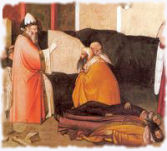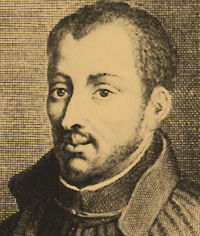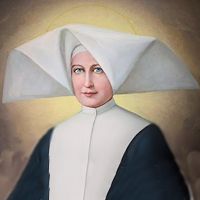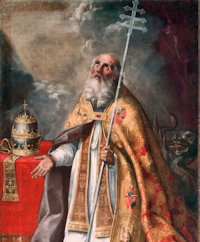Christmas: December 31st
Seventh Day in the Octave of Christmas; Optional Memorial of St. Sylvester I, pope
Other Commemorations: John Francis Regis, Priest (RM); St. Catherine Laboure, Virgin and Religious (RM) ; Other Titles: New Year's Eve
» Enjoy our Liturgical Seasons series of e-books!
Today is the seventh day in the Octave of Christmas. The Church celebrates the Optional Memorial of St. Sylvester I, pope and confessor (died 335 A.D.). He ruled the Church during the reign of Constantine when the Arian heresy and the Donatist schism had provoked great discord. He convoked the first Ecumenical Council of Nicaea.
St. John Francis Regis was ordained into the Society of Jesus in 1630. He was gifted with a marvelous talent for missions, he labored for the conversion of the Huguenots, assisted the needy, and aided in the rescue of wayward women.
St. Catherine Laboure. The Blessed Virgin Mary appeared to her, a member of the Daughters of Charity, three times in 1830 and commissioned her to have made the Miraculous Medal and to spread devotion to it. St. Catherine Laboure was canonized in 1947. It is also the feast of St. James of the Marches who grew up in the turbulence of early 15th Century Europe. Wars were being waged across Western Europe, and the Papal seat of authority was divided between Italy and France.
Seventh Day in the Octave of Christmas—Day Seven The last day of the year is also the feast of St. Sylvester — bishop of Rome in 314. Constantine gave him the Lateran Palace, which became the cathedral church of Rome. Many legends exist about Sylvester. He supposedly cured Constantine from leprosy and later baptized him on his deathbed. New Year's Eve, along with its innocent gaiety, is really a day for serious reflection. On the eve of the civil New Year the children may join their parents in a holy hour, in prayer and thanksgiving for the gifts and benefits which God has given them in the past year, and to pray for necessary graces in the forthcoming civil year.
The last day of the year is also the feast of St. Sylvester — bishop of Rome in 314. Constantine gave him the Lateran Palace, which became the cathedral church of Rome. Many legends exist about Sylvester. He supposedly cured Constantine from leprosy and later baptized him on his deathbed. New Year's Eve, along with its innocent gaiety, is really a day for serious reflection. On the eve of the civil New Year the children may join their parents in a holy hour, in prayer and thanksgiving for the gifts and benefits which God has given them in the past year, and to pray for necessary graces in the forthcoming civil year.
- Day Seven Activity (New Year's Eve Party)
- Day Seven Recipe (Silvesterpunsch)
St. Sylvester
St. Sylvester, a native Roman, was chosen by God to govern His holy Church during the first years of Her temporal prosperity and triumph over Her persecuting enemies. Pope Melchiades died in January, 314. St. Sylvester was chosen as his successor. He governed the Church for more than twenty-one years, ably organizing the discipline of the Roman Church, and taking part in the negotiations concerning Arianism and the Council of Nicaea. He also sent Legates to the first Ecumenical Council.
 During his Pontificate were built the great churches founded at Rome by Constantine — the Basilica and baptistery of the Lateran, the Basilica of the Sessorian palace (Santa Croce), the Church of St. Peter in the Vatican, and several cemeterial churches over the graves of martyrs. No doubt St. Sylvester helped towards the construction of these churches. He was a friend of Emperor Constantine, confirmed the first General Council of Nicaea (325), and gave the Church a new discipline for the new era of peace. He might be called the first "peace Pope" after centuries of bloody persecution. He also established the Roman school of singing. On the Via Salaria he built a cemeterial church over the Catacomb of St. Priscilla, and it was in this church that he was buried when he died on December 31, 335.
During his Pontificate were built the great churches founded at Rome by Constantine — the Basilica and baptistery of the Lateran, the Basilica of the Sessorian palace (Santa Croce), the Church of St. Peter in the Vatican, and several cemeterial churches over the graves of martyrs. No doubt St. Sylvester helped towards the construction of these churches. He was a friend of Emperor Constantine, confirmed the first General Council of Nicaea (325), and gave the Church a new discipline for the new era of peace. He might be called the first "peace Pope" after centuries of bloody persecution. He also established the Roman school of singing. On the Via Salaria he built a cemeterial church over the Catacomb of St. Priscilla, and it was in this church that he was buried when he died on December 31, 335.
Numerous legends dramatize his life and work, e.g., how he freed Constantine from leprosy by baptism; how he killed a ferocious dragon that was contaminating the air with his poisonous breath. Such legends were meant to portray the effects of baptism and Christianity's triumph over idolatry. For a long time the feast of St. Sylvester was a holyday of obligation. The Divine Office notes: He called the weekdays feria, because for the Christian every day is a "free day" (the term is still in use; thus Monday is feria secunda).
—Compiled from Heavenly Friends, Rosalie Marie Levy and The Church's Year of Grace, Pius Parsch
Patronage: animals; for good harvests; stone masons; Order of Saint Sylvester; Locations in Italy: Barberino di Mugello, Branca, Calvisano, Castroreale, Feroleto Antico, Piegaro, Poggio Catino
Highlights and Things to Do:
- Read more about Pope St. Sylvester:
- See St. Sylvester's statue in Basilica of St. Peter's Colonnade.
- St. Sylvester's relics are in Basilica of San Silvestro in Capite in Rome. See the other churches dedicated to St. Sylvester in Rome.
St. John Francis Regis
 Born into a family of some wealth, John Francis was so impressed by his Jesuit educators that he himself wished to enter the Society of Jesus. He did so at age 18. Despite his rigorous academic schedule he spent many hours in chapel, often to the dismay of fellow seminarians who were concerned about his health. Following his ordination to the priesthood, he undertook missionary work in various French towns. While the formal sermons of the day tended toward the poetic, his discourses were plain. But they revealed the fervor within him and attracted people of all classes. Father Regis especially made himself available to the poor. Many mornings were spent in the confessional or at the altar celebrating Mass; afternoons were reserved for visits to prisons and hospitals.
Born into a family of some wealth, John Francis was so impressed by his Jesuit educators that he himself wished to enter the Society of Jesus. He did so at age 18. Despite his rigorous academic schedule he spent many hours in chapel, often to the dismay of fellow seminarians who were concerned about his health. Following his ordination to the priesthood, he undertook missionary work in various French towns. While the formal sermons of the day tended toward the poetic, his discourses were plain. But they revealed the fervor within him and attracted people of all classes. Father Regis especially made himself available to the poor. Many mornings were spent in the confessional or at the altar celebrating Mass; afternoons were reserved for visits to prisons and hospitals.
The Bishop of Viviers, observing the success of Father Regis in communicating with people, sought to draw on his many gifts, especially needed during the prolonged civil and religious strife then rampant throughout France. With many prelates absent and priests negligent, the people had been deprived of the sacraments for 20 years or more. Various forms of Protestantism were thriving in some cases while a general indifference toward religion was evident in other instances. For three years Father Regis traveled throughout the diocese, conducting missions in advance of a visit by the bishop. He succeeded in converting many people and in bringing many others back to religious observances.
Though Father Regis longed to work as a missionary among the North American Indians in Canada, he was to live out his days working for the Lord in the wildest and most desolate part of his native France. There he encountered rigorous winters, snowdrifts and other deprivations. Meanwhile, he continued preaching missions and earned a reputation as a saint. One man, entering the town of Saint-Andé, came upon a large crowd in front of a church and was told that people were waiting for "the saint" who was coming to preach a mission.
The last four years of his life were spent preaching and in organizing social services, especially for prisoners, the sick and the poor. In the autumn of 1640, Father Regis sensed that his days were coming to a conclusion. He settled some of his affairs and prepared for the end by continuing to do what he did so well: speaking to the people about the God who loved them. On December 31, he spent most of the day with his eyes on the crucifix. That evening, he died. His final words were: "Into thy hands I commend my spirit."
He was canonized in 1737.
—Excerpted from Saint of the Day, Leonard Foley, O.F.M.
Patronage: against plague; embroiderers; lace makers; lace workers; medical social workers; social workers; French Jesuits; Sisters of Saint Francis Régis; Regis University; Regis High School (New York City); Regis Jesuit High School (Aurora, Colorado)
Symbols and Representation: Jesuit wearing a leather cape and holding a staff topped with a crucifix
Highlights and Things to Do:
- Read more about St. John Francis Regis:
- His relics are located in La Louvesc, France: Basilica of St. Francis Regis
St. Catherine Labouré
 St Catherine Labouré was born on the 2nd of May 1806 at Fainles-Moutiers, a picturesque village of Burgundy, France. She was the ninth child in a happy family of eleven. God made known the choice of this soul by marking her at an early age with the seal of suffering, for when she was only nine years old she lost her mother.
St Catherine Labouré was born on the 2nd of May 1806 at Fainles-Moutiers, a picturesque village of Burgundy, France. She was the ninth child in a happy family of eleven. God made known the choice of this soul by marking her at an early age with the seal of suffering, for when she was only nine years old she lost her mother.
Saint Catherine Labouré responded to the divine call by entering the Community of the Daughters of Charity of St. Vincent de Paul in Paris. Here, during the first months of her novitiate, she was favored with a number of apparitions of the Blessed Virgin, who confided to her the mission of having the Miraculous Medal made.
Until shortly before her death Saint Catherine kept a strict silence concerning these apparitions, speaking of them only to her confessor, according to the instructions of Our Lady.
During 46 years Saint Catherine witnessed the wonders and miracles wrought through the Medal. During all this time, carefully guarding her secret of the apparitions, she humbly performed her commonplace duties, devoting herself especially to the care of the infirmed men of Enghien, a suburb of Paris. For this she is called the patroness of seniors.
On the 31st of December 1876, Saint Catherine left this earth for heaven, to contemplate there her Immaculate Queen whose love and beauty had captured her heart on earth.
Her body was exhumed 57 years later and found in perfect condition. Even death respected her who had enjoyed the extraordinary privilege of resting her hands on the knees of the Blessed Virgin for more than two hours during one of the apparitions. Saint Catherine was canonized by Pope Pius XII on July 27, 1947.
The simplicity of Saint Catherine's life endears her to everyone. She became a saint by doing her commonplace duties well, for God. This "Saint of Ordinary People" has the secret of sanctity for us all.
—Excerpted from Central Association of the Miraculous Medal
Patronage: pigeon fanciers; pigeons
Symbols and Representation: Daughters of Charity habit; Miraculous Medal
Highlights and Things to Do:
- Read more about St. Catherine Labouré and the Miraculous Medal:
- Make a virtual visit to the Chapel of Our Lady of the Miraculous Medal. There you can see St. Catherine's incorrupt body.
- See Association of the Miraculous Medal.
- Philadelphia is the home of the Central Association of the Miraculous Medal Shrine.






